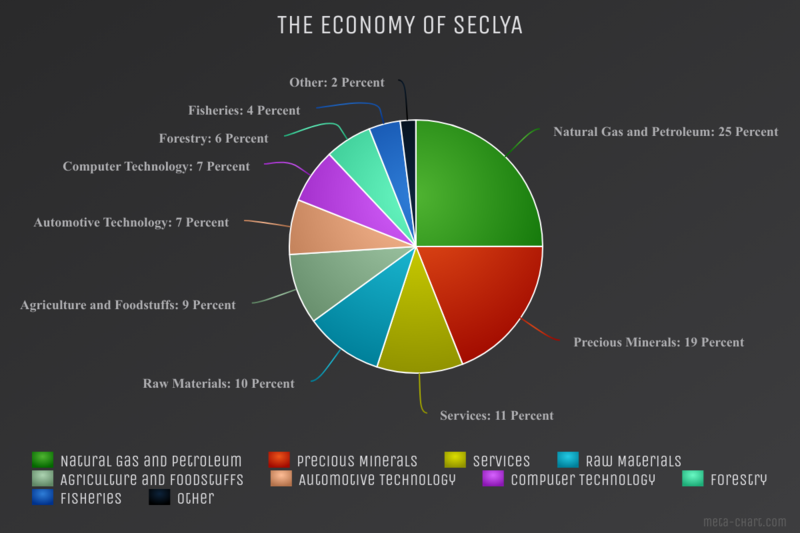Seclya
This article is incomplete because it is pending further input from participants, or it is a work-in-progress by one author. Please comment on this article's talk page to share your input, comments and questions. Note: To contribute to this article, you may need to seek help from the author(s) of this page. |
Saahein Sovereignty of Seclya Casariaat Saahein ria Seclya | |
|---|---|
| Motto: Dus Cresh Achait Vustarius Saahein Glory Eternal to the High Elves | |
| Anthem: Anareth Amorya | |
| Capital | Syva Aethel |
| Largest city | Haanathemar |
| Official languages | Saaheinic |
| Recognised national languages | Hakul |
| Ethnic groups |
|
| Demonym(s) | Seclyai |
| Government | Constitutional Monarchy |
• Ostrax | Ruven I Achax |
• Miax | Issarel Ermys |
| Legislature | The Vulmar |
| Sinaht | |
| Carralei | |
| History | |
• The First Saahein | Circa 25000 BCE |
• The Warring Tribes | 5000 BCE - 2500 BCE |
• Prisoners of the Hakul | 2500 BCE - 2000 CE |
• War of the Leaves | 2000 CE - 2005 CE |
• The Kingdom Age | 2005 CE - Present |
| Area | |
• Total | 5,551,400 km2 (2,143,400 sq mi) |
• Water (%) | 13.12% |
| Population | |
• 2024 census | 13,658,057,006 |
• Density | 118.54/km2 (307.0/sq mi) |
| GDP (PPP) | 2024 estimate |
• Total | $731.29 Trillion |
• Per capita | $53,542.76 |
| GDP (nominal) | 2024 estimate |
• Total | $725.84 Trillion |
• Per capita | $53,143.84 |
| Gini | 25.325 low |
| HDI | 0.912 very high |
| Currency | Cresh (Ꞇ) (CRS) |
| Date format | dd-mm-yy |
| Driving side | right |
| Internet TLD | .sec |
Seclya, officially the Saahein Sovereignty of Seclya (Saaheinic: Casariaat Saahein ria Seclya) is a Gothic Elven Kingdom ruled by the House of Rothilion-Ermys, situated across the south-central area of Gholgoth on the Tiamian Peninsula, south of Amador and Brewdomia. Ruling over a population of 13.6 billion citizens, the Sovereignty also lays claim to the Kritarchic Residuum in Varathron, though it has no functional control over said territory as of 2024. Headed by the duumvirate of Ostrax Ruven I Achax and his consort Issarel Rothilion-Ermys, the country juggles competing demands of its constituent races, the Saahein, Lashein, Lacerta and a small population of Stahd captives left over from its victory in the War of the Leaves against their former Hauklic masters. Most of its population resides in the south of the country, away from the harshness of the Marysia Mountains in the north. The capital city of Syva Aethel is also the country’s newest city, constructed by the elves after the conclusion of the war; its largest city is Haanathemar. It is one of the smallest nations in Gholgoth by population.
Seclya is a constitutional monarchy ruled by the Saahein, a race of elves who along with their Lashein cousins departed from Amador several millennia ago during the Amadorian expansion. The Saahein, like the native Lacerta population, were domineered into submission by the Hakulic and later Seclyai humans that would come to forge their own human empire in the land. Repressing their magical heritage, the Saahein would rise up with their Lashein and Lacerta allies during the War of the Leaves, overthrowing the yoke of their human captors and forming a high elvish kingdom in Seclya. The Royal Family of Seclya is formed by the marriage of an adopted son of Maeralya of Amador, Ruven Rothilion and the Amadorian Issarel Rothilion-Ermys. Part of the mission of the royal family is to pass down the newly released tradition of magic among the elves, along with creating a semi-autonomous partition for the Lacerta who sided with the elves during the war. Assisted by Amador, the country has rebounded from the war to become a highly-technological society of magic wielders.
The country has emerged from the war as a burgeoning center for the arts and sciences, with education becoming a central priority of the government. The highly centralized bureaucracy is dominated by its centerpiece organization, the Vulmar, its legislative body. Restoring the elves to their rightful highborn status, continuing the geological and ecological recovery from the war and contributing to a developing high-income economy are the chief concerns of the legislature and the government at large. The country sponsors numerous institutions of higher learning to help the elvish and lacertan population recover from the war and build a brighter future for themselves and their progeny. Despite its immense progress thanks to the Imperium Intervention during the war and its aftermath, Seclya in many ways remains a rebuilding nation trying to find its place among the Gothic north.
History
The Lacertan Hegemmony
The End of the Hegemony
Rise of the Hakul
The Early Clans
The Arrival of the Lashein and Saahein
Braedel and the Religion of Apocalypse
Braedelism Takes Hold
The Late Kingdom
The Seclyai Invasion
Braedel's Offspring
The Seclyai Formation
The Modern Order
The Freedom of the Hein
The Rise of the Stadh
The Creation of the Brean
The Human-Otherkin War
The War Begins to Turn
The Saahein Sovereignty
Geography
Climate
Biodiversity
Government
National
Subdivisions
Foreign Relations
Saahein-Amadorian Relations
Seclya maintains important relations with Amador through a series of formal documents and through the marriage of Ruven Rothilion-Ermys and Issarel Ermys. Both nations posses a mutual defense pact, sworn to defend one another should one be attacked. Formal relations were established following the end of the War of the Leaves, which saw Amador intervene and ultimately help the Saahein and Lashein elves overthrow the previous human-dominated Selcyai government.
Seclya and Amador are intertwined economically and culturally and have close diplomatic relations following the end of the War of the Leaves. Both militaries regularly carry out joint trainings and the navies of both nations form a a collective barrier against Scandinvan aggression. As a show of trust, almost complete unrestricted travel is permitted between the two countries.
Amador has made an enormous economic impact in Seclya following the rise of the Saahein Sovereignty in an effort to rebuild the war-torn country and to revitalize the shattered economy. Both nations have established an annual grant to the Sovereignty in exchange for the establishment of the Saahein-Alfar Free-Trade Agreement (SAFTA), a free-trade agreement which eliminates tariffs and taxed among imported and exported goods between the two nations.
Military
Law Enforcement
Demographics
Population
Religion
Largest Cities
Health
Education
Primary
Secondary
Tertiary
Arcane Universities
Culture
Symbols
Sports
Literature
Arts
Media
Influences
Amadorian Influence
Amador has greatly influenced Seclya following the War of the Leaves, though significant instances of cultural ascension were placed throughout the millennia following the exodus of Seclya's elven species.
Economy
Main article: Economy of the Saahein Sovereignty of Seclya
The economy of the Saahein Sovereignty is one of the most developed in Gholgoth, thanks in no small measure to the pre-war focus on economic strength by the Hakulic-Seclyai and their free market orthodoxy, which has been adapted by the new confederation of Sovereignty races into a highly articulated artisan economy. Assistance from the Kingdom of Amador in the form of trade agreements have also helped the new elvish economy recover greatly from the War of the Leaves. The country boasts a high standard of living with redistributive wealth policies to care for the poorest of the land. The Gross Domestic Product (GDP) is estimated at around $725.84 Trillion NSD, with a GDP Per Capita (Nominal) of $53,143.84 NSD. Seclya maintains an average compounded economic growth rate of 3.7% annually, and has seen its unemployment rate drop below 4% for the first time in 2024 since before the war. The highly specialized economy is one of the largest in Gholgoth.
Seclya possesses a mixed market economy with Elven characteristics, with a highly skilled labor force, relatively low levels of corruption, and a high level of technological innovation thanks to its ancient roots and the assistance in development by the Kingdom of Amador. The country’s central government operates as a dirigiste force on the economy as a whole, exerting regulatory oversight and redistributive policies to help spread capital throughout the economy and the population in general. The country’s citizens receive a universal basic income (UBI) to help meet basic needs, while certain inalienable rights like universal child and healthcare, free higher education and housing and nutritional assistance are held sacrosanct. The country is a net exporter of goods, though the trade surplus has begun shrinking in recent years as the explosive population growth has led to higher consumption and a greater market demand for goods. Seclya’s top exports include agriculture, artisan goods, forestry products, furniture, precious minerals, raw materials and an abundance of mineral resources like copper, lithium, and tin.
The Seclyai have one of the highest average household incomes in Gholgoth, with a high median household income thanks to efforts to reduce the wealth gap through redistributive economic policies. Income inequality has dropped by 2% year-on-end since the War of the Leaves, though a sizable wealth gap still remains thanks to the pre-war legacy of the market economy. The poverty rate hovers around 4% thanks to government interventions in healthcare, housing, education and food assistance. Food security is a highly prized government intervention thanks to the country’s agricultural output, strong agricultural subsidies and the social safety net. The large welfare state, backed by the strong Seclyai economy, guarantees paid vacation time, maternity and paternity leave, and compulsory health coverage through the state-owned healthcare system. Artisan guilds and trade unions have collective bargaining rights with their employers for better compensation packages.
Structure
The Seclyai economy is structured around resource extraction and exports, maintaining a trade surplus of roughly $245 Billion NSD. Much of the country’s infrastructure from the prewar years was designed to bring material wealth out of the country’s interior to its major ports. Efforts in recent years to establish a more egalitarian economic infrastructure has led to increased efforts to keep wealth localized to municipalities, but resource exports remain the bread and butter of the Seclyai economy. Liquified natural gas and refined petroleum are the two largest economic powers in the Seclyai economy, accounting for almost a quarter of the nation’s economic output. Companies such as Valvaris, Glynmenor and Ilixalim are some of the largest energy corporations in Gholgoth by trade value. There has been a push in recent years to divest from the energy sector as it currently exists due to concerns about climate change; the endowment group Hagre Fenlen is one of the largest green technologies lobbies in Seclya, and have spearheaded the movement by the government to reduce its own carbon footprint. Nevertheless, energy exports remains the largest economic sector and will continue to be the dominant resource export for some time to come, with the country expected to produce more than 20,500,250 barrels of oil per day by January 2025.
Precious minerals and raw materials account for nearly thirty percent of the economic output of the Seclyai economy. Gold and silver ore account for sixty percent of the precious minerals market in Seclya, with diamond and ruby production accounting for another thirty percent. It is estimated that Seclya sits atop one of the largest diamond reserves in central Gholgoth, though production has decreased year-on-end thanks to renewed climate protections placed on the mining industry. Precious metals such as platinum and palladium are found in abundance in the central interior of the country and have become an extremely lucrative trade in the twenty-first century. Metals such as aluminum, copper, tin and zinc are mined extensively, and the production of iron ore has increased by more than half since the turn of the century. Raw materials represent the fastest growing economic sector in the country, with its market share increasing by ten percent over the past fifty years. Copper production in particular has seen a large jump in overall market share. Though downsized in importance with new climate initiatives by the government, coal production remains a valuable resource for Seclya.
The Seclyai economy relies on the Cresh (Ꞇ) as its currency, backed by the country’s strong economy and military strength in the central Gothic lands. The Amadorian Aeures (₳) is utilized as a de facto currency following the War of the Leaves between 2000 and 2005. The country’s principal economic center is the city of Haanathemar, where the Naeris Stock Exchange and the CRAELEE Index are located, two of the largest in Gholgoth by trade volume and market capitalization. Haanathemar is considered one of the country’s major economic and cultural centers, featuring the largest municipal GDP in the country. Seclya is considered a regional leader in resource production, and has a growing technological community advocating research, sciences and technology. The country's economy is fueled by abundant natural resources, a well-developed infrastructure, and high productivity. The Amadorian Imperium is the largest trading partner of the Saahein Sovereignty.
Tourism
The tourism industry has greatly expanded in the years following the War of the Leaves, with the country opening its doors to foreign tourists for the first time and advocating for increased visitation to the country’s ubiquitous mountain resorts and baths. Seclya’s interior mountains are rich with geologic activity, creating natural hot springs that draw in hundreds of thousands of visitors from abroad each year. Major metropolitan areas such as Morn Iyhelume and Isyh Alora have also increased their advertising budget drawing in both domestic and foreign-born tourists by the hundreds of thousands. War tours showcasing the history and heritage of the War of the Leaves is a prominent historical tourist industry in the country. Gambling is a burgeoning industry in Seclya, with the act legalized throughout the country, leading to the rise of casino resort hotels in the major metropolitan areas: Mathathas is considered the gambling and resort hotel capital of Seclya, with more than thirty casino resorts to its name. Also of interest are the nation's indigenous Lacerta communities, where traditional art and literature, theater and sports are showcased to rapt audiences. The country's ever-expanding educational system brings in millions of foreign-born students each year, giving rise to college towns that draw in millions of family members each year. Summer tourism dollars are an important part of the local coastal economies as the nation's citizens flock to the beaches during the warm months. Air travel to Seclya has become cheaper in the post war years thanks to increased air infrastructure.
Infrastructure
Seclya possesses a unique infrastructure owing to its Hakulic past, with much of the country united by the military aims of the former Seclya Formation and thus possessing a robust infrastructure network designed to move large amounts of people and freight about in a secure and timely manner. The country is perhaps most known for its famous underground highways, large bored tunnels through bedrock that were originally purposed for military usage and have since become the nation’s main civilian highway infrastructure. Following its victory in the War of the Leaves, the Saahein Sovereignty adopted the Ifa Serine Protocol in developing a robust public transportation network in and around the nation’s cities. The engineering projects created through the use of elven labor and magicks are some of the largest in Gholgoth during the twenty-first century. Much help was derived from the Amadorian Imperium following the war in helping to rebuild a war torn society.
The nation’s geography has favored the development of water-based transportation through the usage of its navigable rivers and canals. As a major exporter of energy, minerals and raw materials, the country’s infrastructure is designed to extract resources from the interior and move them to the country’s major port facilities. Civilian traffic on the waterways has increased in recent years thanks to the country’s push to revitalize its green industry sector, lessening the emissions from the country’s overland road system. Air travel has become popular in the postwar years thanks to the Amadorian example of airship travel. Construction has commenced in most major cities for ‘sky ports’ for airships of varying sizes to accommodate long-distance travel between cities.
Energy
Seclya’s energy grid is a mixture of various formats, with the country having invested heavily in green energy sources and renewables in the postwar years. As of 2024, more than seventy percent of the country’s energy production comes from nuclear power stations, making it one of the most robust nuclear energy grids in Gholgoth. The country increased its nuclear production to its current levels through investment in hypermodern reactor designs, boasting plants that can utilize nuclear waste in its reactors. Cold fusion technology has become a major priority for the country owing to the Ushya Accords which sets a target for nuclear fusion energy by the year 2045. Two research laboratories in Hela Thalas and Isyh Alora have produced small fusion reactions in their reactors, leading to the hope that the country will meet its fusion project deadline ahead of time.
Twenty percent of the nation’s energy comes from geothermal energy thanks to its highly active geological resources, with the remaining ten percent coming from hydrothermal, natural gas, solar and wind energy. The country’s last oil and coal fired energy plants went offline in 2021 and 2023, respectively. The country is blessed with an abundance of oil and natural gas deposits, making it one of the region’s largest liquified natural gas and petroleum exporters. The country has set a target of 2050 to reach net zero emissions and to reduce GHC emissions by eighty percent by the year 2040. Owing to Amadorian support, Seclya has emerged from the postwar period as one of the greenest nations in Gholgoth.
Transportation
The Saahein Sovereignty has spent much in the way of fiscal and materiel resources in rebuilding the country’s transportation grid following its victory over the Hakulic peoples in the War of the Leaves. With support from its Amadorian allies, the country has embarked on a massive public transportation spending spree along with conversion of its former wartime assets into civilian use infrastructure. Public transportation infrastructure accounted for nearly ten percent of discretionary spending by the government in 2024, owing to efforts to expand its airship infrastructure. Much of the public transportation networks have gone green, with electric vehicles and light rail networks contributing to the push for cleaner transportation technology. The country’s public transportation grid in totality boasts a seventy percent eco-friendly proportion, with the stated aim of raising that to full capacity by the year 2040. Municipal grid development has become a major government initiative in recent years.
Road Network
Despite its investment in public transportation infrastructure, Seclya is still dominated by the automobile. An extensive network of highways and roads crisscross the major Seclyai cities, with urban road networks stretching for miles across the landscape. The Royal Highway Authority (Vulred Omalynn Terissys) monitors and observes road-based transportation in the country, creating standardized rules for infrastructure including bridges and viaducts, pavement composition and lane width. Uniquely however, the country’s infrastructure network does not include expressways between the major cities in the traditional sense. The former highway system of the previous government has been repurposed for usage as bike trails, greenspaces and solar and wind farms. The transformation of the overland road network was part of the nation’s greenbelt initiative designed to encourage public transportation and limit the presence of gas-consuming cars on the road in favor of electric vehicles. Today electric vehicles make up forty percent of the automobiles on the road, with that number expected to rise by twenty percent in 2030 as the nation utilizes its lithium deposits. Seclya seeks to eliminate gas-powered engines from its roadways entirely by 2060.
In place of a traditional highway network, the Seclyai government has uniquely turned military infrastructure into civilian infrastructure with the creation of the Andrathath Larrel highway system. Prior to the War of the Leaves, the Hakulic government had built large underground tunnels traveling for hundreds of miles, connecting major cities with one another for use as a military transportation grid safe from aerial bombardment or assault. The Saahein government repurposed these long military tunnels into commercial thoroughfares, with the requisite infrastructure all based underground. Carbon capture technology limits the amount of carbon dioxide and other emissions from reaching the surface, thus helping to combat climate change by lessening the nation’s carbon footprint. This expensive infrastructure is buoyed by a special tax levied in the form of a toll charge to enter the network of underground road connectors. Thanks to the herculean efforts of the government, and with support from its allies, the underground connectors function like a robust expressway system for the country. It is one of the most technologically advanced roadway networks in all of Gholgoth, costing more than $300 billion annually to maintain.
Rail
The utilization of railway infrastructure is not new in Seclya; the country had developed a robust network of rail lines for moving cargo freight and military personnel during the Hakulic administration. In the years since the War of the Leaves however, the Saahein government of Seclya has made it a mission to improve railway access for individuals in commercial and civilian usage. Maglev technology has made high speed rail infrastructure a reality between the major cities, helping boost public transportation through railway transportation of people and goods. Old railway lines have been revitalized and used for long and short distance cargo freight hauling. More than 200,000 miles worth of commuter rail lines exist in Seclya, making it one of the largest railway networks in Gholgoth. Commercial and civilian rail transit is publicly owned in Seclya.
Of particular interest is the prevalence of rail transit as a means of public transportation in the major metropolitan cities. Every town over five thousand people are guaranteed public transportation funding from the central government in Syva Aethel, while those under that threshold can self-fund a public grid at their own discretion. While most every city has state-owned buses, shuttles and trolleys operating on their roads, many cities of size have turned to rail transit for their public infrastructure needs. Light rail is one of the most popular forms of public transit in the country, with more than three dozen cities employing the technology as of 2024. Monorail and subway transit are also popular options in Seclyai cities.
Airfare
The abundance of public transportation options and the country’s unique road infrastructure made air travel internally less of a factor prior to the War of the Leaves. With travel restricted to military personnel and civilians lacking the legal agency to travel about, air travel was never a priority for the Hakulic government. Under the Saahein administration of Ruven and Issarel, however, air transportation has become a major investment opportunity for the government. The country has invested in development projects for hundreds of airport terminals across the country, and have publicly invested in new aviation developers like Ilyana Air to help the country’s young airline industry take flight. More than a dozen carriers now operate at over fifteen thousand airports around Seclya, an increase from twelve thousand airports in the year 2010.
The government has attempted to capitalize on the increase in civilian air traffic in Seclya by bolstering its own public transportation grid through air power. Air taxis in the form of state-owned helicopters ferry passengers to and from major cities while domestic carriers receive public funding to help expand their operations. Of particular interest is an imported custom from the Amadorian Imperium in the form of airships, zeppelins capable of ferrying a throng of people from one city to the next. These airships are considered public transportation owned by the state, and have led to the development of considerable infrastructure in the form of docking ports on skyscrapers in the country's major metropolitan areas.
By utilizing existing buildings as 'sky ports' for the zeppelins, airship transportation has become a viable means of long-distance public transportation for those unable or unwilling to purchase airfare on the nation's airlines. Between the nation's domestic and international airline carriers and the airship transportaiton service offered by the Saahein government, more than one hundred million people annually utilize air transport in Seclya, a five hundred percent increase from the immediate post-war figures in 2005.
Seaports
As an industrialized, resource-based economy, Seclya’s port system is both robust and well-developed. Having inherited a system put in place by the prior Hakulic administration, the Saahein Sovereignty continued investing in port infrastructure well into the reign of Ruven and Issarel. More than five hundred port facilities, including the rise of Ianphine Superports have been invested in over the twenty-year reign of the Seclyai duumvirate, with more than a dozen new port facilities at created deep water harbors under construction as of 2024. Green energy technologies like surf and hydroelectric power are fueling new ports, helping to reduce their carbon emission footprints. Moreover, air and rail infrastructure is helping to bring more cargo freight to Seclyai coastal installations around the country. The government spends more than $100 Billion annually on port expansion and upkeep. With port facilities overextended in some areas, the government has begun to build artificial ports in harbors and at sea, using smaller boats to ferry cargo from container ships into the main port facility. These Keyyra Ports have exploded in growth, and been paired up with artifical landing strips at sea and concrete islands used by the Seclyai military for the purposes of defense of commercial traffic and offshore port facilities. Another $50 Billion is spent annually attempting to prevent cargo theft and tampering at sea in a boost to the country's port infrastructure. The country's seaports represent a monumental asset to the Seclyai economy and its resource-driven export marketplace.
Water Network
Like their Amadorian cousins, the Seclyai possess a bounty of navigable waterways that aid in the ship-based transport of people and cargo to and from cities along the many rivers in Seclya. The country’s investment in river-based transport ranges from ferries that convey cars and foot traffic across waterways in the country to river barges that transport people greater distances between cities. These “river taxis” are some of the newest civilian transportation infrastructure in the Saahein Sovereignty thanks to Vulmar legislation in 2019 authorizing the creation of a fleet of barges and ferries for transportation purposes. Most of the traffic on Seclyai riverways is commercial in nature however; cargo ships pass through waterways such as the Aiduin, the Halflar and the Tiarsus Rivers, transporting freight to the country's many port facilities.
River-based commercial and freight traffic has come under intense scrutiny over the past two decades as climate activists and environmentalists have protested the ecological damage done to the nation’s rivers. In fact, much of Seclya’s domestic waterways were heavily polluted by industrial runoff in the pre-war years, as the Hakulic government placed little emphasis on ecological affairs or environmental protections. Much has been done to help repair waterways to their natural health over the postwar period, including limiting the dumping of chemical byproducts into waterways and spending countless amounts of money and resources to clean the rivers themselves.










